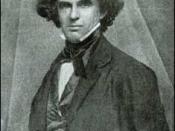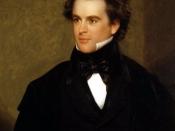Nathaniel Hawthorne's Life Reflected in Young Goodman Brown Often times when we meet a person and we know something about them, such as their religion or economic background, we put a title on them. Basically, we stereotype them based on what we know about them. For example, when we think of Puritan's, we most likely think "Goody two-shoes."ÃÂ "The Puritan's considered the Bible as the true law of God that provided guidelines for church government"ÃÂ ("Puritans"ÃÂ). Therefore, people look upon Puritans as being pure. They don't think Puritans engage in any immoral acts because they attend church so frequently. They think of them to be sinless. However, is it possible for a person not to think evil thoughts or never sin? Nathaniel Hawthorne learned that it is not. Hawthorne grew up under the Puritan influence. As he grew up, he learned of his ancestor's contributions to the Salem witch trials.
After learning this he began to turn against Puritanism. "Many critics believe that the guilt Hawthorn felt over his family history prompted him to write about themes exploring the evil of man and original sin"ÃÂ ("Nathaniel Hawthorne"ÃÂ). In Hawthorne's short story "Young Goodman Brown"ÃÂ he writes about a man and his faith in himself, his wife and the community around him.
The story begins with Goodman Brown going on a journey into the forest where he must face the temptations of the devil. Upon entering the forest he is suspicious of every rock and tree, thinking something will jump out at him. Yet he continues on his journey until he meets up with a man. This man has an evil appearance and is in fact the devil. Goodman Brown continues along the journey with the devil and remains strong. He sticks to his faith and refuses any temptations...


